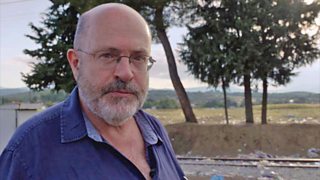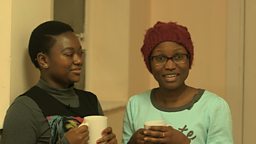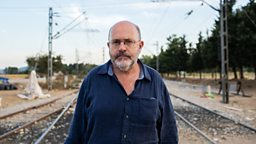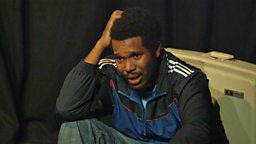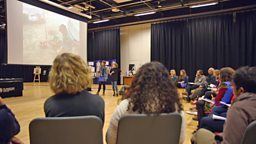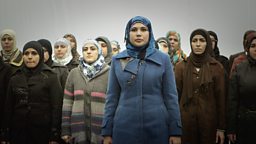John Sweeney: 'We owe it to refugees to tell their stories'
2 December 2015
Veteran ÃÛÑ¿´«Ã½ journalist JOHN SWEENEY has witnessed the European migrant crisis first hand, reporting for Panorama in The Long Road: Europe’s Border Crisis in September and ÃÛÑ¿´«Ã½ Newsnight’s Finding Azam in October. Here, alongside a selection of extracts from Panorama, he writes for ÃÛÑ¿´«Ã½ Arts about the importance of telling the human stories behind the statistics.

What must it be like to be a child on the long road from Syria to northern Europe? Witnessing the horrors you’re running from, the horrors you’re running through, the drizzle of the soul you end up in – what have you seen and how do you deal with it?
Refugees don’t make wars. It’s the other way round. The war in Syria is under-reported because people like me are afraid of having their heads chopped off. That is not an unreasonable fear. The consequence is that public sympathy for those running from this pitiless war between one side that uses poison gas and the other that film beheadings in broadcast quality high definition is perhaps less deep than it should be.
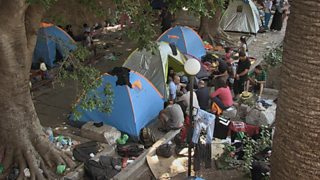
On the Greek island of Kos a father from Raqqa – which fell to the so-called Islamic State or ISIS last year - explained to me what happened one day when he was walking through the city:
"It’s all blood and decapitated heads hung up on roundabouts. My three-year-old daughter saw the heads hung up with her own eyes. They would publicly execute in front of everyone. We were out and passed by Al-Na’em roundabout when we saw around 55 heads spiked onto metal poles."
And then came the bombs, dropped by the forces of Bashar al-Assad’s forces – the Syrian ruler whose family have held sway over the country for 45 years:
"My wife would cover the baby’s ears, while I covered our daughter’s ears and we would hold them tight so they wouldn’t hear the sounds. One day a missile landed on the ground close to us. Since then, whenever my daughter hears that sound she goes mad."
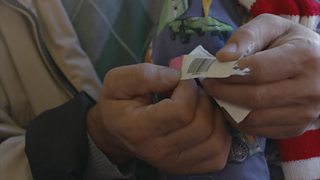
There’s the horrors of the sea crossing, $1,200 a head from Bodrum in Turkey to Kos in Greece – the Turkish people smugglers pocketed $120million in August alone - and then the endless waiting for a number before you can move.
In Greece, Macedonia, Serbia you get a number. In Hungary, when its borders were open, you get a barcode and a stay in a reception centre covered in razor wire. When Hungary’s borders were closed, the long road shifted one hundred miles to the west and now the refugees – and some economic migrants, coming along for the ride – shiver in the misty dawn, waiting to dribble in to Croatia.
In Serbia, I met a little boy who scalp had been burnt bald by a regime barrel bomb that had killed his auntie and another little boy, Azam, whose jaw had been broken in a car accident when he was sleeping on the street in Macedonia.
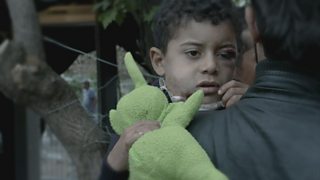
He was with his uncle, who took him before he was properly treated out of hospital in Belgrade all the way to Germany. Some of the people on the road are not angels; far from it.
As reporters go, I was built in an old Soviet tractor factory but some of this stuff makes me weep.
And then when the people get to northern Europe, what do they find? I went to one reception centre in Munich. It was a large grey box made up of small grey boxes surrounded by a big grey fence in a grey business park. Even the sky was grey. Better than bombs and gas, sure, but grim.
I got home to London after one of my trips along the pipeline of humanity and woke at three in the morning to find a rave riot on my street, ghouls and ghosties in Halloween costume lobbing bricks and lumps of concrete at the cops because their party plans had been stymied. What would a seven-year-old running from Kobani make of that?
Some of this stuff is so raw that it will take time for artists and playwrights and poets to work on it, but work on it they must
Some of this stuff is so raw that it will take time for artists and playwrights and poets to work on it, but work on it they must. The story of Syria’s extraordinary cultural riches needs to be told, of the loss to the world caused by ISIS’s destruction of the temples at Palmyra, the beheading of the archaeologist, Khaled al-Asaad, who, at 81, refused to leave his beloved bits of old stone.
The stories, too, of journalists like John Cantlie, who have vanished into the ISIS killing machine. But most of all artists need the tell the stories of the ordinary, extraordinary Syrians and Iraqis on the run and how and where that running away from killers will end. And, running with them, the stories of the child refugees.
I saw my first refugees in 1983 in the Indian Himalayas. They were Tibetans on the run from China’s imperial peace – a peace, to them, not worthy of the name – in their homeland. Since then, I’ve seen people run from killing in Rwanda, Bosnia, Iraq, Chechnya, Albania… The list goes on and on.
Perhaps the most haunting of all were the scenes I witnessed in 1991, when Saddam turned his anger on the Kurds who had rebelled against him and they fled to Iran, a mud-slide made of people. On night I saw a baby dying in front of my eyes, then the sun came up and kids began to sing "Down with Saddam" from the back of a lorry like it was a fun nursery thyme.
Some of this stuff informed my first novel, Elephant Moon, about Anglo-Burmese refugees on the run from the Imperial Japanese Army in 1942. One morning, when they are at death’s door, they are helped by a team of elephant men and their great, magnificent beasts. Perhaps, together, they have a chance of making it alive to the safety of India.
The story of those child refugees singing In An English Country Garden in 1942 is wildly different from those of the Syrian refugees in 2015 but it is also the same: they’re running from killers and we owe it to them, as best we can, to tell their stories, to bear witness to their suffering.
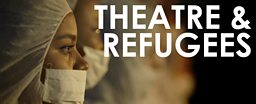
Watch the full programme
-
![]()
Available on ÃÛÑ¿´«Ã½ iPlayer until 30 September 2016.
